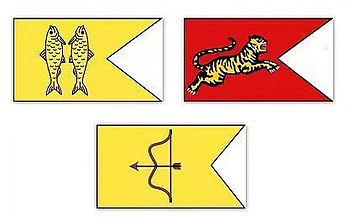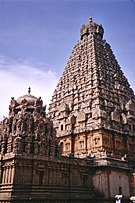


| Part of a series on |
| History of Tamil Nadu |
|---|
 |
| Main |
| Sangam period |
| Medieval history |
| Categories |
The Three Crowned Kings, were the triumvirate of Chera, Chola and Pandya who dominated the politics of the ancient Tamil country, Tamilakam, from their three Nadu (countries) of Chola Nadu, Pandya Nadu (present day Madurai and Tirunelveli) and Chera Nadu (present day Kerala and some parts of Tamilnadu) in southern India. They signalled a time of integration and political identity for the Tamil people. They frequently waged war against one another under a period of instability and between each other, held control over Greater Tamilakam from 6th century BCE to the 13th century. After being defeated by the Pandyas, the Cholas fled to Devicottah and are later mentioned in various texts that participated in wars in the 16th century.
Origins
The etymology of the Tamil word for the three kings – Moovendhar (pronounced Mūvēntar) – comes from Tamil: மூ, romanized: mū, lit. 'three' and Tamil: வேந்தர், romanized: vēntar, lit. 'king',. They are mentioned by Megasthenes and the Edicts of Ashoka, and first in Tolkappiyam among Tamil literature who was the first to call them Three Glorified by Heaven (Tamil: வான்புகழ் மூவர், Vāṉpukaḻ Mūvar). Ptolemy and the Periplus of the Erythraean Sea mention three kingdoms ruling Tamilakam.
Pandyas

The Pandyas were the earliest of the Muvendhar and were of high antiquity being mentioned by Kātyāyana and Valmiki. However the establishment of a Pandya territory is not known until the sixth century under King Kadungon who liberated the Pandya country from the Kalabhras. Xuanzang reports that Jainism was flourishing while Buddhism was declining during this period. They were famous for being patrons of the Tamil Sangams which were held in their capital, Madurai. Pliny mentions the Pandya country and its capital. The large number of Roman coins from Emperor Augustus to Emperor Zeno found in Madurai shows that trade flourished among Rome, Greece and Tamilakam. Two embassies sent from the Pandya dynasty to Emperor Augustus were recorded. The Roman and Greek writers praise Korkai (now called Tuticorin or Thoothukudi) as the seaport of the Pandyas.
Cholas
The Cholas were a prominent dynasty in South India, and they played a significant role in the Sangam Age, which is generally considered to span from 300 BCE to 1297 CE. During this period, the Cholas engaged in extensive trade both within the Indian subcontinent and with foreign regions. Their trading activities helped them amass wealth, expand their influence, and contribute to the growth of their kingdom.
The Cholas had a well-developed maritime trade network, which allowed them to establish trade links with various regions, including Southeast Asia, Sri Lanka, the Arabian Peninsula, and East Africa. They possessed a strong navy and used it to protect their trade routes and maintain control over the seas. Their trading activities were not limited to goods but also extended to cultural and intellectual exchanges.
One of the key commodities in Chola trade was spices. They actively participated in the spice trade, importing and exporting various spices such as pepper, cardamom, cinnamon, and ginger. The Cholas also traded in other valuable commodities like precious stones, pearls, textiles, ivory, and perfumes. They were known for their craftsmanship and exported exquisite bronze sculptures, pottery, and textiles, which were highly sought after in foreign markets.
Cheras
The Cheras were another prominent dynasty during the Sangam Age in South India, alongside the Cholas and the Pandyas. The Chera kingdom, located in present-day Kerala and Kongu Nadu, had a significant impact on trade, economy, and cultural exchange during that time.
The Cheras were known for their extensive trade networks and maritime activities. They had access to important ports along the Malabar Coast, such as Muziris (modern-day Kodungallur), Tyndis (modern-day Ponnani), and Nelcynda (modern-day Cranganore). These ports served as major centers for trade, attracting merchants from different parts of the world.
The Cheras played a crucial role in the spice trade, which was highly lucrative during the period. They were actively involved in the export of spices like black pepper, cardamom, cinnamon, and ginger. These spices were in high demand in the Roman Empire and other foreign markets, and the Cheras capitalized on this demand to amass wealth.
Apart from spices, the Cheras also traded in other valuable commodities such as ivory, pearls, textiles, precious stones, and forest products. They had access to the rich resources of the Western Ghats and the forests of Kerala, enabling them to export goods like timber, teak, sandalwood, and medicinal herbs.
Literature
The Silappatikaram alludes to the solar ancestry of the Cholas and the lunar ancestry of the Pandyas. It does not mention anything about the ancestry of the Cheras. The 15th-century Tamil Mahabharata of Villiputtur Alvar describes the Chera king as from the fire dynasty, retaining the solar and lunar origins for the Chola and the Pandya kings, respectively. The Tiruvilayatar Puranam (or Thiruvilaiyadal Puranam), possibly from the 17th century, also states that when Brahma re-created the world after a deluge, he created the Chera, Chola and the Pandya kings as descendants of the fire, the sun and the moon, respectively.
Chola Purva Patayam ("Ancient Chola Record"), a Tamil language manuscript of uncertain date, contains a legend about the divine origin of the three crowned kings. According to it, the Shramana king Shalivahana (also known as Bhoja in this story) defeated Vikramaditya, and started persecuting the worshipers of Shiva and Vishnu. After failing to kill Shalivahana with a rain of fire, Shiva created three kings: Vira Cholan (Chola), Ula Cheran (Chera), and Vajranga Pandiyan (Pandya). The three kings came to bathe together at the triveni sangam (three-river confluence) in Thirumukkoodal, and formed an alliance against Shalivahana. Next, they went through a number of adventures at various places, including Kashi and Kanchi. With the blessings of Durga, they found treasure and inscriptions of Hindu kings from the age of Shantanu to Vikramaditya. They then reached Cudatturiyur (possibly Uraiyur), where Vira Cholan wrote letters to all those who worshipped Shiva and Vishnu, seeking their help against Shalivahana. A number of people assembled at Cudatturiyur to support the three kings' campaign. When Shalivahana heard of this preparation, he marched towards the south and took possession of the strong citadel at Tiruchirappalli. The three kings sent their envoy to Shalivahana, asking him to surrender and renounce his faith. When he refused, they and their allies assembled an army at Thiruvanaikaval. From an inscription that they had earlier found at Kanchi, they realised that there was a subterranean entrance into the Tiruchirappalli fort. They sent a few soldiers who entered the fort and opened its Chintamani gate. Their forces then entered the fortress, and defeated Shalivahana. Chola Purva Patayam dates Shalivahana's defeat to the year 1443 of an uncertain calendar era (possibly from the beginning of Kali Yuga).
Notes
- Also known as the Three Glorified by Heaven, World of the Three The Tamil Kings, or Muvendar.
References
- ^ A. Kiruṭṭin̲an̲ (2000). Tamil culture: religion, culture, and literature. Bharatiya Kala Prakashan. p. 17.
- Peter Schalk, A. Veluppillai (2002). Buddhism among Tamils in pre-colonial Tamilakam and Ilam: Prologue. The pre-Pallava and the Pallava period. Uppsala University Library.
- van Bakel, M.; Hagesteijn, Renée; van de Velde, Piet (1994). Pivot politics: changing cultural identities in early state formation processes. Het Spinhuis.
- Proceedings of the Indian History Congress. Proceedings of the Indian History Congress. 1997.
- Pollock, Sheldon (2003). reconstructions from South Asia. University of California Press. p. 298.
- The journal of the Numismatic Society of India, Volume 47. Numismatic Society of India. 1985. p. 91.
- Chaurasia, Radhey Shyam (2002). History of ancient India: earliest times to 1000 A.D. Atlantic Publishers & Dist. p. 246.
- Tripati, Rama Shankar (1987). History of ancient India. Motilal Banarsidass. p. 31.
- ^ Alf Hiltebeitel 2009, p. 472.
- Alf Hiltebeitel 2009, p. 471.
- William Cooke Taylor (1838). Examination and Analysis of the Mackenzie Manuscripts Deposited in the Madras College Library. Asiatic Society. pp. 49–55.
Bibliography
- Alf Hiltebeitel (2009). Rethinking India's Oral and Classical Epics: Draupadi among Rajputs, Muslims, and Dalits. University of Chicago Press. ISBN 978-0-226-34055-5.
